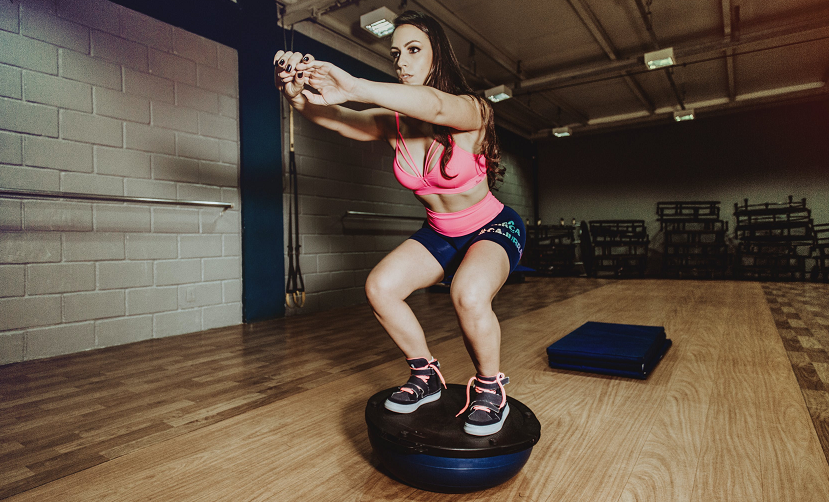Become stronger by including squats in your exercise routine. Squats target the large muscles in the hips, back and thighs. These muscles propel us forward while walking, running and jumping. Increased strength and endurance in the hips, thighs and back optimizes athletic performance and lowers injury risk.
In part one of this article series I wrote about proper squatting technique, aerobic fitness, anaerobic fitness, squatting safety, stance width, depth, spinal decompression and knee health. In part two I am writing about the various types of squats and how to best utilize each type.
Bodyweight Squats: Use bodyweight squats to develop strength, coordination, balance and endurance. Bodyweight squats are a great starting point. Bodyweight squats can be included in your warm-up and in your training program. Bodyweight squats are a valuable tool in evaluating squatting movement patterns and ironing out technique flaws. Bodyweight squats are the mainstay in a large number of exercise classes.
Fitball Squats: Fitball squats are bodyweight squats performed with an exercise ball between your back and a wall. Stand with your back to the wall and place the ball between your back and the wall. Use the ball to guide your motion as you descend and ascend. Fitball squats are a valuable tool to perfect technique and to perform high repetitions.
BOSU Ball Squats: Perform squats on a BOSU ball to improve ankle strength, coordination, balance and proprioception. Vary the intensity by using multiple arm positions including hands on hips, arms out to the sides, arms straight out front and arms straight over head. Advanced trainees can hold a medicine ball during BOSU ball squats. Start with flat side of the BOSU ball down and progress to using the flat side up.
Single Legged Squats or Pistols: Single legged squats are an advanced exercise that increases strength, flexibility, balance and coordination. Practice your technique repeatedly with a sturdy exercise bench behind you. Use the bench as a safety net and as a guide for squatting depth. Start with a shallow depth and advance to greater depths.
Anchor Squats: Perform anchor squats with dumbbells or kettlebells. Hold one dumbbell or one kettlebell with both hands or one weight with each hand. With your arms straight hold the weight like an anchor between your knees. Use a wider stance and squat to a depth where the weight almost touches the floor. The wide stance required for anchor squats targets the inner thighs. Anchor squats are a safe alternative to front squats and barbell squats for those with back issues.
Dumbbell Squats: Hold a dumbbell in each hand with your arms hanging at your sides. Dumbbell squats are an excellent alternative to barbell squats. Advance from bodyweight squats to dumbbell squats. Dumbbell squats are a very effective method for high repetition training.
Front Squats: Develop strength, power, balance and explosiveness with the front squat. Hold a barbell, two dumbbells or two kettlebells on the anterior aspect of your shoulders. Holding the weight in the front shifts the center of gravity and places a larger emphasis on the lower aspect of the quadriceps muscles.
Two arm positions exist in barbell front squats. Bodybuilder style: Arms crossed in front with palms on the opposite shoulders. Olympic weightlifter style: Wide grip on the bar with wrists bent backwards.
Barbell Squats: Barbell squats are also known as back squats. A barbell is held across the upper back. Barbell squats are a favorite among most strength athletes. They are the most well-known and most utilized form of squats. Barbell squats build strength, power, explosiveness and endurance.
Begin with light weight and increase resistance gradually. When training heavy always use a spotter. If using very heavy weight and low repetitions, protect your spine and wear a weight lifting belt. When using very heavy weight have a training partner spot you. Safety should be your first priority. Perfect form is vital to prevent injury. Practice prefect form repeatedly.
Conclusion: If your spine and knees are healthy enough, use squats as the nucleus of your resistance training. Increase the strength and endurance in your back, hips, glutes, quadriceps and hamstrings with perfect squatting technique. Increase your personal records by utilizing squats to improve your health and fitness.
Dr Donald A Ozello DC of Championship Chiropractic in Las Vegas, NV
Web Site: http://www.championshipchiropractic.com/
Blog: https://www.championshipchiropractic.com/wordpress/
YouTube: https://www.youtube.com/user/drdozellodc/videos
Twitter: https://twitter.com/drdozellodc
Facebook: https://www.facebook.com/Championship-Chiropractic-280141628688300/
LinkedIn: https://www.linkedin.com/in/dr-donald-a-ozello-dc-716b3233
“Running: Maximize Performance & Minimize Injuries” https://www.amazon.com/Running-Performance-Chiropractors-Minimizing-Potential/dp/1493618741
**Disclaimer: Always consult a medical professional before beginning an exercise program. Always work within your capabilities. Never perform an exercise that elicits or increases pain or symptoms. Reading this article and viewing the linked videos does not take the place of seeing a medical professional. Please visit a medical professional for evaluation, diagnosis & treatment.

